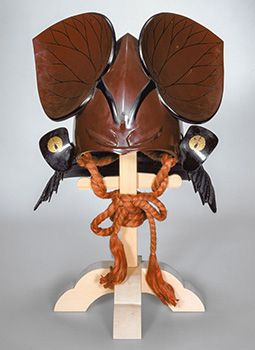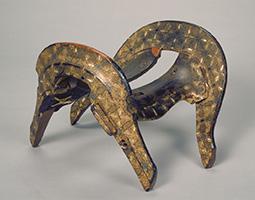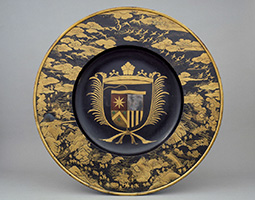May 2022
- English
- 日本語
The History and Culture of Lacquer in Japan

Hidaka Kaori, professor at the National Museum of Japanese History 
A raden and maki-e “Cosmetic Box with Carriage Wheels in Water” (National Treasure, Collection of Tokyo National Museum) (12th century) (22.4 cm x 30.6 cm x 13.5 cm)

A lacquered comb discovered at the Torihama shell mound site in Fukui Prefecture (Jomon period, 6,100 years old) (Collection of Wakasa History Museum) (8.9 cm x 7.8 cm) 
A lacquered helmet with hollyhock leaf motifs (Edo period) (Collection of National Museum of Japanese History) (32 cm x 20 cm x 23 cm) 
A raden and maki-e decorative saddle (16th to 17th century) (Collection of National Museum of Japanese History) (26.8 cm x 38.8 cm x 9 cm) 
A raden and maki-e decorative coffer for export (16th to 17th century) (Collection of National Museum of Japanese History) (12.7 cm x 23 cm x 15.5 cm) 
Maki-e dish with family crest and a motif featuring mountains, rivers and human figures. This family crest is of the Hinlopen family, which engaged in trade in Amsterdam (Collection of National Museum of Japanese History) (late 17th to 18th century) (53 cm diameter)

Lacquer has been deeply connected to the culture and lives of Japanese people since ancient times. We spoke with Hidaka Kaori, a professor at the National Museum of Japanese History, about the history and culture of lacquer in Japan.

When was lacquer, made from the sap of the lacquer tree, first used in Japan?
It is thought that the lacquer tree, which was indigenous to the Asian continent, was brought over to Japan during the Jomon period (about 16,000 to 2,900 years ago) and spread here. On studying wood found at an archaeological site in Fukui Prefecture, it was determined that it was from a lacquer tree that lived approximately 12,000 years ago. This is currently the oldest lacquer tree in Japan, but it is unclear how it was used at the time.
However, many examples of earthenware, wooden containers, combs, and worn ornaments such as earrings that used lacquer tree sap as a coating material have been unearthed from archaeological sites from the early Jomon period, about 7,000 years to 5,500 years ago. It is clear that lacquer was used by people from this time, if not sooner.
Lacquer is actually not that easy to handle. A rash will form if it touches the skin, and it is not easy to grow lacquer trees. Regardless, the reason why lacquer spread across Japan was because it was extremely useful. For example, applying lacquer to a container prevents water leakage and increases durability. It also makes an object beautiful when painted on. It was also used as a glue to join broken pieces of earthenware together. Lacquer has been used in this way since the Jomon period for its excellent practical and decorative qualities.
Lacquer techniques have been refined since the Heian period (end of the 8th century to end of the 12th century), a time when court culture flourished in Japan. What kinds of techniques were developed?
The most famous technique is maki-e. With this decorative technique, a brush is used to draw patterns in lacquer on the surface of lacquerware. Gold or silver powder is then sprinkled on and sticks to the lacquerware before the lacquer dries. The origins of maki-e are not known,* but we do know that maki-e lacquerware came to be produced in Japan from the 8th century onwards. Maki-e saw great development during the Heian period when aristocratic culture flourished. Lacquer, gold, and silver were extremely valuable, and maki-e cost a great deal of money. But the wealthy aristocrats used maki-e not only for various furnishing goods, but also in the building of their own homes, temples, and other buildings. Maki-e was an important method of expressing the aristocratic sense of beauty.

Lacquerware was being produced in other parts of East Asia during this same period, but maki-e was not used at all. For this reason, since the 10th century, maki-e was exported to other Asian countries as a Japanese specialty and became quite popular.
How did lacquerware later spread to the general public in Japan?
Because the lacquerware used by the aristocracy had many overlapping layers of painted lacquer, it required a large amount of lacquer and was extremely expensive. But around the 11th century, a method was developed to create finished lacquerware with one or two coats of lacquer on top of the initial rough coating painted over the wood grain using a mixture of charcoal powder and persimmon tannins, which is fermented liquid extracted from the persimmon fruit. Using this technique, the amount of lacquer used was reduced and it became possible to create lacquerware cheaply. Everyday rice bowls, plates, and other lacquered tableware spread among the samurai, Buddhist monks and priests, and urban merchants, and by the 16th century, lacquerware was used among farmers, as well.
During the Edo period, when the Tokugawa shogunate ruled Japan for about 260 years from the start of the 17th century, the variety of products painted with lacquer increased dramatically as craft techniques developed. For example, helmets, armor, and other weapons, horse equipment, and furniture. But for most people, lacquerware was expensive. When ceremonies such as weddings and funerals were held, large groups of people would gather for meals, and so many pieces of lacquered tableware became necessary. However, it was not easy for a single family to prepare all of this lacquered tableware. For this reason, it was common to borrow the tableware from other families or share them as a community.

You can see lacquerware from Japan in old European castles and museums. When did exports of Japanese lacquerware to Europe begin?
Exports of Japanese-made lacquerware to Europe began at the end of the 16th century, if not sooner. The lacquerware was exported to mainly Portugal and Spain then England, the Netherlands, and other countries. As the Tokugawa shogunate had given permission for trade with Japan only to the Netherlands among Western nations, from the start of the 17th century they became the sole exporter of Japanese-made lacquerware.
At the time, Japanese lifestyles were quite different from those in Europe, so there were many items of lacquerware used in Japan that could not be used in Europe if exported as is. This is why most of the lacquerware to be exported was specially created after receiving an order from Dutch merchants and made to fit the lifestyles and preferences of Europeans. This export lacquerware was mainly made by artisans in Kyoto. We know that Dutch merchants would call these artisans to Dejima, a man-made island in Nagasaki that was the center for trade with the Netherlands, to place their orders, and would stop in Kyoto on the way to Edo (present-day Tokyo) to check the items being produced.

What kind of exported lacquerware was created?
For example, chests with many drawers, large coffers with lids, furniture such as tables, and tableware such as plates and coffee cups. A major feature of this exported lacquerware is the intricate patterns created with various techniques, including maki-e and raden (mother of pearl inlay), a technique where thinly cut fragments of seashells are used for decoration. You could say this was used to make the lacquerware appear more exotic and luxurious.
Lacquerware was also imported from other Asian countries at the time, but Japanese-made lacquerware was particularly admired, and was popular in Europe. The word “japan” begins to appear in lists of assets of the 17th century European aristocracy. This is because the word “japan” came to be used in Europe as a word referring to lacquerware in general.
One such enthusiast of Japanese-made lacquerware was Marie Antoinette (1755–1793), queen and wife of King Louis XVI of France. In her room at the Palace of Versailles was a shelf displaying a small collection of Japanese-made lacquerware. Her collection is now housed in the Palace of Versailles Museum, the Louvre Museum, the Guimet Museum, and more.

Professor Hidaka, you’ve been researching lacquerware for many years now. Can you tell us about the allure of lacquer?
The transparency and color of the lacquer changes greatly depending on the processing technique used after collecting the sap from the lacquer tree. It is also possible to create various beautiful effects by changing the materials painted with lacquer or the techniques used. The variations are virtually endless. That is the allure of lacquer.
I use bowls and other lacquerware in my everyday life, and they also have various practical advantages. For example, lacquerware is poor at conducting heat, so it never becomes too hot to hold, even with hot drinks. It is also good at keeping hot drinks from cooling down. It is extremely lightweight and it has a soft feeling when it is held in your hands or put up to your mouth.
And by re-coating lacquerware, you can use the same objects for a very long time. The world is aiming to become a sustainable society now. Lacquerware is undoubtedly suited to that kind of society.

* According to one theory, maki-e was brought over to Japan from the technique devised in continental China by around the 8th century at the latest.

